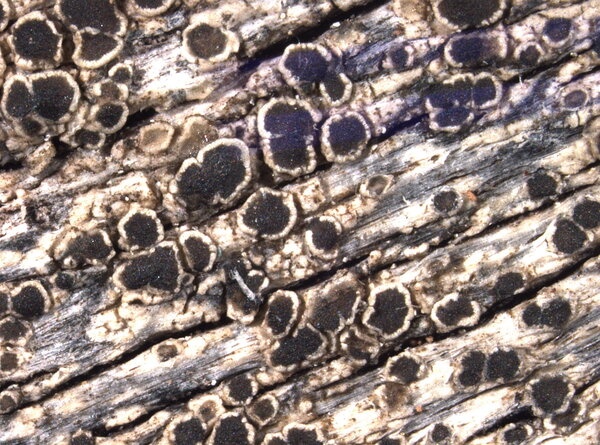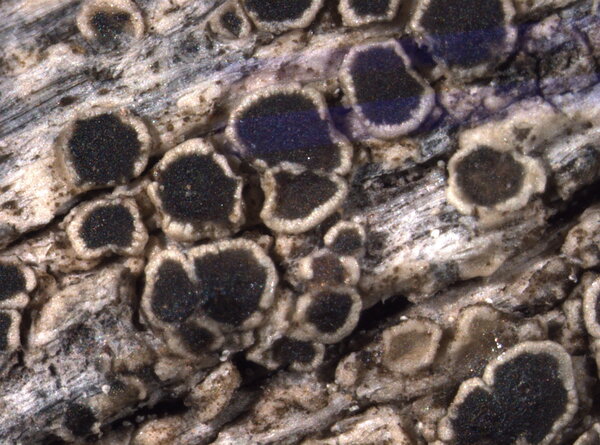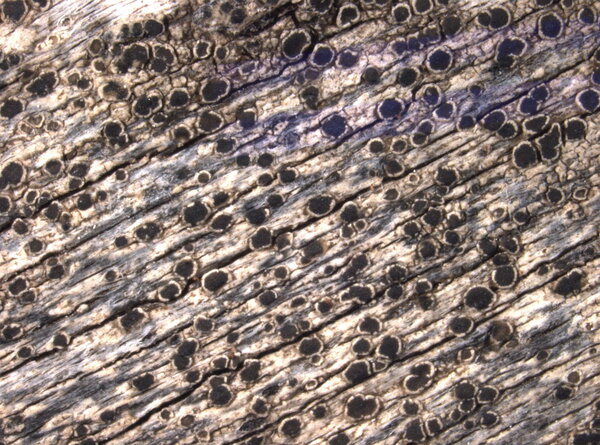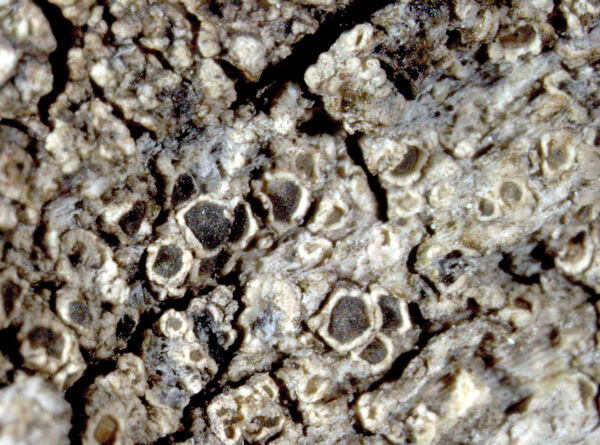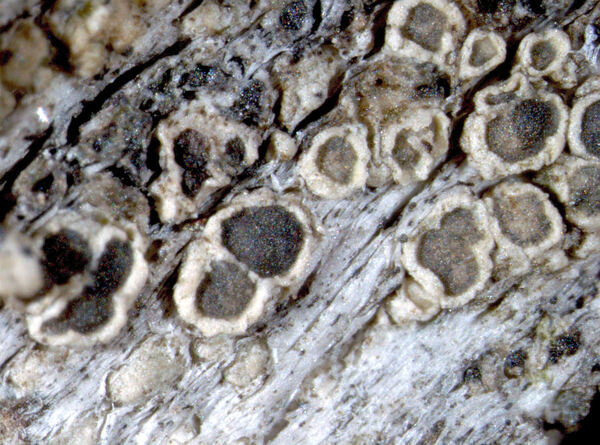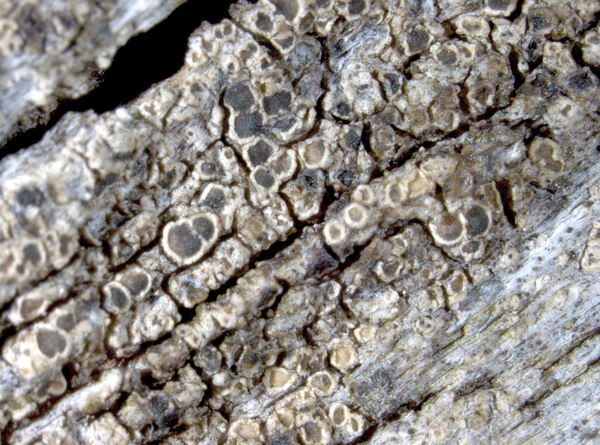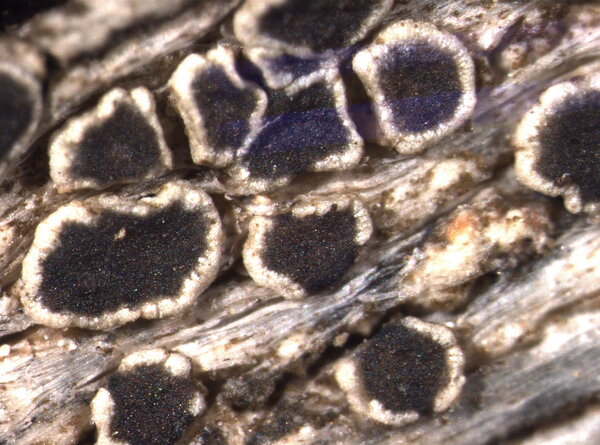Lecanora mughicola Nyl.
Flora, 55: 248, 1872.
Synonyms: Lecanora varia var. alpina Kremp.; Lecanora varia var. melanocarpa Anzi
Distribution: N - Frl, Ven, TAA (Nascimbene & Caniglia 2002c, Nascimbene & al. 2006e, 2007b, 2008c, 2022, Nimis & al. 2015, Ivanovich & al. 2025), Lomb (Printzen 2001, Gheza 2019b), Piem (TSB 33223), VA (Piervittori & Isocrono 1999), Lig (van den Boom & Brand 2008). C - Laz (van den Boom & Brand 2008). S - Cal (Puntillo 1996).
Description: Thallus crustose, poorly evident or episubstratic, rimose to warted-areolate, whitish to beige, rarely brown to dark brown, sometimes with a green tinge, dull or more often slightly glossy, appearing waxy in the herbarium, the areoles angular to irregular in outline, 0.3-2 mm wide, flat to strongly convex. Apothecia lecanorine, rounded to irregular in outline, mostly densely crowded, adpressed or sessile, 0.2-0.4 mm across, with a dark brown to jet black, rarely pale brown or pale ochre, often dark grey- or bluish-discoloured, usually epruinose weakly concave to flat disc and a whitish beige, somewhat prominent, persistent, slightly crenulate thalline margin. Thalline exciple 35-125 µm wide laterally, (55-)110-165 µm wide at base, corticate, the cortex (9-)13-43(-62) µm wide laterally, (9-)15-35(-43) µm wide at base, with abundant algae and with small brownish granules soluble in K; proper exciple colourless or faintly olive-green, (16-)24-41(-59) µm wide; epithecium faintly olive-green to dark green on darker discs (sometimes only strokes of pigmentation present), N-, covered by a thick epipsamma of golden-brown granules soluble in K; hymenium colourless to yellowish brown, (50-)60-80(-85) µm high, with brown granules; paraphyses simple or sparingly branched and anastomosing, 1-1.5(-2) µm thick at mid-level, the apical cells to 4.5 µm wide, strongly pigmented; hypothecium colourless or pale brown, (68-)80-122(-160) µm high. Asci 8-spored, clavate, very thin-walled, with a K/I+ blue, tall tholus penetrated by a faintly amyloid apical cushion, the wall K/I-, surrounded by a blue outer layer, Lecanora-type. Ascospores 1-celled (rarely 1-septate), hyaline, narrowly ellipsoid, (10-)12-14(-16) x (3.5-)4.5-6(-7.7) µm, the wall c. 1 µm thick. Pycnidia colourless, immersed. Conidia of two types: a) bacilliform, straight, or slightly curved, microconidia measuring 7-10 x 1-1.5 µm, b) strongly curved, thread-like leptoconidia measuring 15-20 x 1-1.5 µm. Spot tests: thallus K-, C-, KC-, P-, UV-. Chemistry: thallus with isousnic acid; apothecia with the Cinereorufa-green pigment.Note: a circumboreal-montane lichen related with Lecanoropsis, found on hard lignum, mostly of conifers in upland areas, with optimum in the subalpine belt; common only in the Alps, much rarer in the mountains of Southern Italy. For further details see Printzen (2001), van den Boom & Brand (2008), and Ivanovich & al. (2025).
Growth form: Crustose
Substrata: lignum
Photobiont: green algae other than Trentepohlia
Reproductive strategy: mainly sexual
Commonnes-rarity: (info)
Alpine belt: absent
Subalpine belt: common
Oromediterranean belt: absent
Montane belt: rare
Submediterranean belt: absent
Padanian area: absent
Humid submediterranean belt: absent
Humid mediterranean belt: absent
Dry mediterranean belt: absent

Predictive model
Herbarium samples
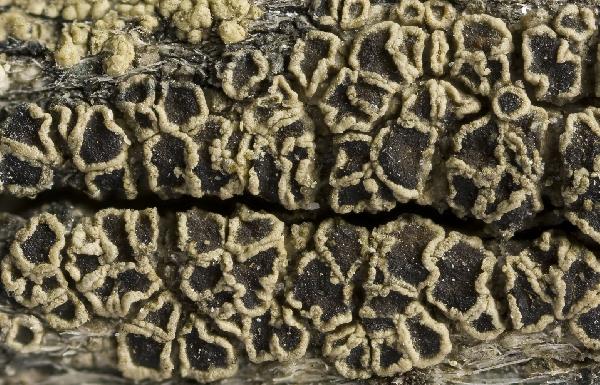
Ulrich Kirschbaum CC BY-SA 4.0 - Source: https://www.thm.de/lse/ulrich-kirschbaum/flechtenbilder
Austrian Alps
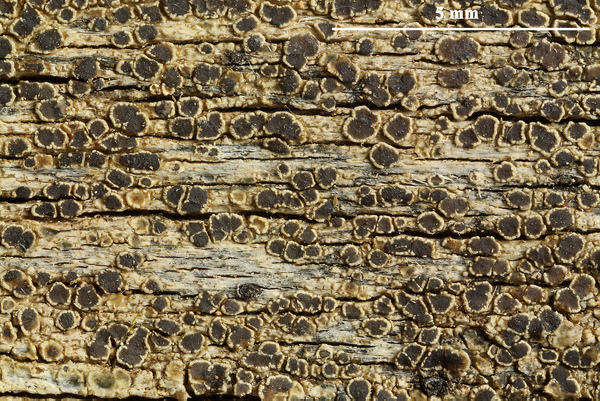

Felix Schumm - CC BY-SA4.0
[20913], Albania, Northern Albania, Malëisi e Madhe district. Bjeshkët e Nemuna mountains, between the village Boga and Theth, slopes just east below the Qafa e Tërthores, near the road to Theth 41°23'10'' N, 19!45'00'' E, 1699 m, on wood of stumps (Pinus).. Leg. J. Hafellner (no 80551), M. Tretiach, L. Muggia, M. Piccotto & J. Marka, 14.8.2007, det. J. Hafellner. LICHENOTHECA GRAECENSIS. NR. 457.
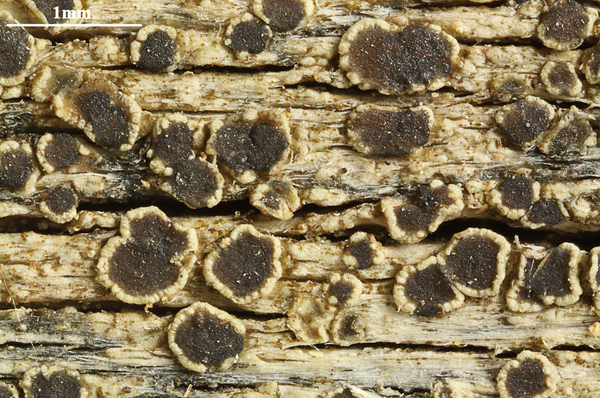

Felix Schumm - CC BY-SA4.0
[20913], Albania, Northern Albania, Malëisi e Madhe district. Bjeshkët e Nemuna mountains, between the village Boga and Theth, slopes just east below the Qafa e Tërthores, near the road to Theth 41°23'10'' N, 19!45'00'' E, 1699 m, on wood of stumps (Pinus).. Leg. J. Hafellner (no 80551), M. Tretiach, L. Muggia, M. Piccotto & J. Marka, 14.8.2007, det. J. Hafellner. LICHENOTHECA GRAECENSIS. NR. 457.
Growth form: Crustose
Substrata: lignum
Photobiont: green algae other than Trentepohlia
Reproductive strategy: mainly sexual
Commonnes-rarity: (info)
Alpine belt: absent
Subalpine belt: common
Oromediterranean belt: absent
Montane belt: rare
Submediterranean belt: absent
Padanian area: absent
Humid submediterranean belt: absent
Humid mediterranean belt: absent
Dry mediterranean belt: absent

Predictive model
| Herbarium samples |

Ulrich Kirschbaum CC BY-SA 4.0 - Source: https://www.thm.de/lse/ulrich-kirschbaum/flechtenbilder
Austrian Alps


Felix Schumm - CC BY-SA4.0
[20913], Albania, Northern Albania, Malëisi e Madhe district. Bjeshkët e Nemuna mountains, between the village Boga and Theth, slopes just east below the Qafa e Tërthores, near the road to Theth 41°23'10'' N, 19!45'00'' E, 1699 m, on wood of stumps (Pinus).. Leg. J. Hafellner (no 80551), M. Tretiach, L. Muggia, M. Piccotto & J. Marka, 14.8.2007, det. J. Hafellner. LICHENOTHECA GRAECENSIS. NR. 457.


 INDEX FUNGORUM
INDEX FUNGORUM
 GBIF
GBIF
 DOLICHENS
DOLICHENS
